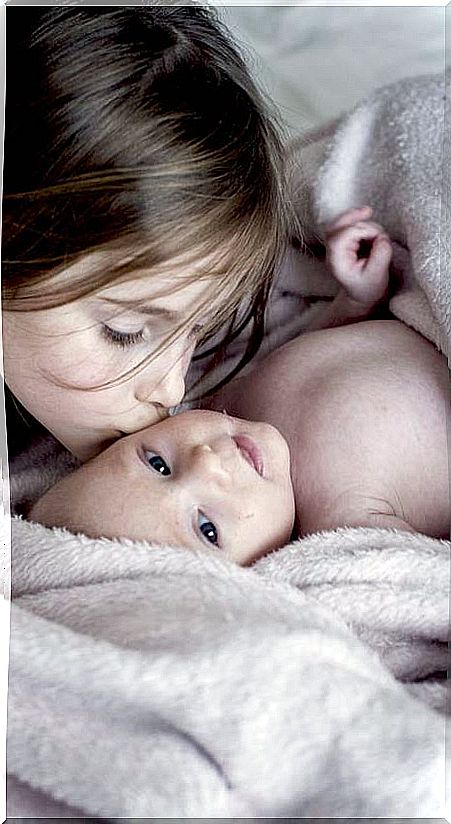Fostering Autonomy From Love
Supporting and respecting children is essential to satisfy their needs and guarantee autonomous development. We must be vigilant and understand its evolution.

The family is the first group of people with whom we come in contact and, during the first years, it is essential for physical and emotional survival. In her womb we are born and develop, and in her we have the first relational and affective experiences, which will configure the form of interaction that we will repeat throughout our lives. In addition, it is a social and cultural reflection of the time that we have had to live.
In the family we develop a large part of our self-concept and self-esteem, we learn to relate to the world and we incorporate ways of satisfying our needs and taking others into account. We learn values, ways of being and doing and a series of rules, customs, rituals and relationship patterns that persist over time.
The family is, for all this, more than the sum of the people that make it up. It is a web of interrelationships where they influence each other. As the pediatrician and psychiatrist Donald W. Winnicott said, “each individual needs to travel a long path that goes from being fused with the mother to becoming a different person, related to the mother, and with the mother and father as a couple; from that moment on, the journey takes place within the territory known as the family ”.
The people who make up the family evolve together and go through vital moments in which they grow.
The two fundamental challenges of the family group are to create a feeling of belonging and, at the same time, to facilitate separation and the construction of one’s own identity. It is about providing roots and a safe place to always go to, while at the same time providing sufficient autonomy to fly and for each person to build their own life.
This process begins very early, although during the first months there is that fusion of the baby with its mother. As the pediatrician and psychoanalyst Margit Mahler says : “the biological birth of the human infant and the psychological birth do not coincide in time […]. We call the psychological birth of the individual the process of separation-individuation ”.
The pleasure of exploring
It is around the first year of the baby, although before he experiences the experience of feeling separate and recognizes the other as a different body, when the primary individuation process begins.
He begins to stand up, to walk, and physically changes his existential position: he can move only to explore. And around 18 months, their need to assert themselves and the desire to gradually achieve their autonomy increases.
That progression in autonomy allows you to have access to the world. It is about offering you the opportunity to learn to be self-reliant, even though the caregiver remains close by.
Approaching that moment with respect means not intervening ahead of time, letting him go find the ball that has escaped him instead of giving it to him.
Sometimes we anticipate ourselves, driven by impatience, lack of time or because our gaze is elsewhere. For example, when a child is learning to dress and we dress him to finish earlier. Other times, we precipitate autonomy and force changes for which he is not yet mature, such as removing the diaper early or pretending that he sleeps alone and continuously throughout the night. These circumstances disrupt the natural self-regulation of their development and create unnecessary stresses.
Positive accompaniment
The healthy autonomy is to be achieved through a process of individuation with emotional support and respect accompaniment. The challenge is to support the child’s will with patience and presence.
Another important question is to know that this process of individuation is reactive : creatures carry it out through denial and difference. For this reason, it is healthy for boys and girls to put energy into asserting themselves, in choosing their own things. With the “no” they are building their identity. They are telling us: “you are one person and I am another.”
A good way to react to a refusal is to give them options to choose from.
That boys and girls contradict us at certain evolutionary moments is not a sign of a conflictive relationship, but rather it responds to a healthy and necessary internal infantile process. Understanding it like this will help us not to fall into the temptation of thinking that they want to annoy us, that they are capricious or that they want to dominate us. It is important that we do not enter into unnecessary power struggles and that we learn to accompany these stages with respect, flexibility and firmness at the same time.
A good way to react to a child’s refusal to do something that we adults think is necessary for them to do is to give them options so that they can choose. For example, if you have to get dressed, we can give you a choice between two clothing options: “Do you wear this or this one?” In this way we do not impose anything on him or fight, but we give him a margin to decide. It makes you feel respected, and it is also a good way to help you learn to make decisions and take responsibility for your choices.
In other cases, we will facilitate their learning by allowing them to experience the natural consequences of an action : for example, if we let them check that it is cold outside, it will be much easier for them to put on their jacket.
Pass adolescence
The second individuation process occurs in adolescence and reactivity is characteristic here as well. However, now the focus is the social and the peer group. But even though the main reference has changed, parents are still significant figures.
If their individuality and the construction of their own identity are respected, adolescents are more likely to mature with a structured and strong self, and this step through adolescence will be easier and more enriching for children and parents.
The other challenge of the family is to facilitate a sense of belonging that assures the adolescent his place in the family group and lets him know that he can always return to it. That feeling, in addition to being built by all the things we have in common, is achieved when the family meets the support needs that we all have.
Support is paying attention, being interested and communicating affectively with the person who is going through a difficult time. It is not to fix or do things for him, but to accompany him and only intervene when he really cannot do them alone. A difficulty pushes the boy or girl to learn, and only when we see that they are going to abandon what they are doing, that their energy drops and the difficulty becomes frustration or anguish, can we intervene and support them.
Laura Perls, creator of Gestalt therapy along with Fritz Perls and Paul Goodman, said that contact can only be positive and creative when it occurs within the framework of a good supportive relationship.
Each family carries out these two main objectives – respect and support for the child first and then the adolescent – following a series of repetitive patterns that define both the relationship between its members and the relationship it has with the outside. These guidelines are defined based on cultural rules and family rules themselves.
They are, in the words of the American psychotherapist Virginia Satir, “vital, dynamic and very influential forces in family life”; agreements that allow or limit behaviors and ways of relating, which can be implicit, explicit, conscious or unconscious.
Opposing attitudes
- In families whose members have little personal space, difference is not allowed and individuation is difficult. Conflicts are often avoided and agreements and similarities are overrated. Emotional contagion is also frequent in them. This tendency facilitates that there is a lot of belonging, important when support is necessary, but which can be conflictive at times when it is essential to facilitate separation, such as in adolescence.
- There is another type of family whose tendency is the opposite: there is distance between its members and the fact of valuing individuation highly has a negative impact on them, as the feeling of belonging and the experience of support are diminished. They are families whose members do not approach each other in anger or affection. There is an overvaluation of privacy and they tend to keep their concerns and problems to themselves, with difficulty asking for help.
Only by respecting the development process of each person and giving them the adequate support they need at all times can we achieve the necessary balance to build fertile and healthy family relationships, and thus allow both the security transmitted by the roots and the freedom necessary to fly.
Four fundamental ideas
Both children and adolescents need parents who are attentive to their development and respectful of them at all times.
1. Be informed
Having data on the emotional development of children is essential. Knowing what we can expect from them, we can act with respect. Creatures do not do things to annoy; They do what they can and what they know with the capacities and maturity that they have at all times.
2. Beware of the verb to be
Saying “you’re bad” is not the same as saying “I don’t like what you just did.” The messages with the verb to be go directly to the formation of the children’s self-concept. If they are very frequent and negative, they result in a conflictive self-image and a very low self-esteem. On the other hand, when we refer to something that you have done that can be modified, we convey to you that we are all wrong and that errors can be repaired.
3. Let them choose
Recognizing them as different people is important so as not to interfere in choosing their own path : we cannot place our needs, frustrations, dreams or expectations on them.
4. The common welfare
It is necessary to leave space for the needs of all the people in the family nucleus to coexist. Although we have a responsibility to meet the needs of the little ones, we cannot neglect our own. So they too learn to take care of themselves.









